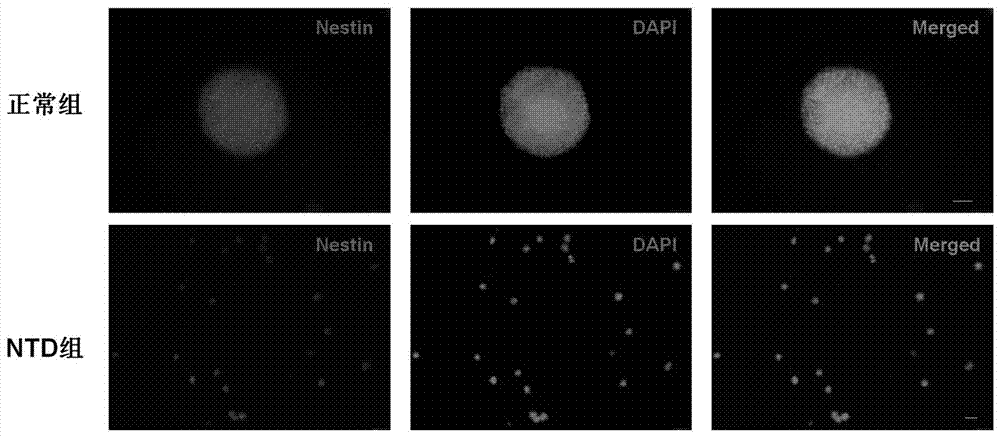NTDs (neural tube defects) rat embryo animal model and constructing method thereof
A technology of animal models and construction methods, applied in the direction of animal cells, vertebrate cells, embryonic cells, etc.
- Summary
- Abstract
- Description
- Claims
- Application Information
AI Technical Summary
Problems solved by technology
Method used
Image
Examples
Embodiment 1
[0039] Example 1: Retinoic acid intervention to construct a C57BL / 6 mouse embryo NTDs model.
[0040] At 18:00 p.m., the C57BL / 6 mice were mated in a cage with a male-to-female ratio of 2:1, and the vaginal plug was taken out at 8:00 the next morning to check the vaginal plug. The day when the vaginal plug was found at 12:00 noon was defined as 0.5 days pregnant (E0.5d ).
[0041] The obtained pregnant mice were randomly divided into a control group (normal group) and an experimental group (NTDs group). On E7.5d, the pregnant mice in the experimental group were given 19-23 mg / kg of retinoic acid solution prepared with sesame oil by intragastric administration. model; control group of pregnant mice given the same volume of sesame oil.
[0042] On E10.5d, the pregnant mice were sacrificed by cervical dislocation, the abdomen was wiped with 75% ethanol, a small piece of skin was pinched, cut along the midline of the abdomen to the level of the nipple line, and then cut along bot...
Embodiment 2
[0047] Example 2: Culture of NTDs mouse embryonic NSCs.
[0048] The brain vesicle tissues of E10.5d mouse embryos in the normal group and the NTDs group were separated and transferred to 15ml centrifuge tubes. Add a small amount of DMEM / F12 medium, blow and suck repeatedly with a 1ml pipette until no tissue pieces can be seen with the naked eye, filter with a 200-mesh filter, centrifuge at 1000rpm for 5min, and discard the supernatant. Add NSCs proliferation medium (DMEM / F12 medium supplemented with 2% B27, 20ng / ml EGF and 20ng / ml bFGF), mix well by pipetting, and adjust the cell concentration to 1×10 6 / ml, inoculated in culture flasks, placed at 37℃ / 5%CO 2 Incubator suspension culture.
[0049] figure 2 It was shown that after culture, the proliferation ability of NSCs in normal group and NTDs group was significantly different. The NSCs in the normal group could form cell colonies on the 4th day of primary culture, and the colonies increased significantly on the 6th da...
Embodiment 3
[0050] Example 3: Identification of NTDs mouse embryonic NSCs.
[0051] Adjust the concentration of NSCs in normal group and NTDs group to 1×10 5 / ml, inoculated in a 24-well plate coated with polylysine, 1ml per well, placed at 37°C / 5% CO 2 Proliferate for 24 hours in the incubator. Using conventional immunofluorescence operation method, Nestin antibody was selected for identification of NSCs (anti-Nestin: 1:500).
[0052] From image 3 It can be seen from the results that, similar to NSCs of normal mouse embryos, the cells isolated and cultured from brain vesicles of NTDs mouse embryos also express Nestin protein, which proves that they are NSCs.
PUM
 Login to View More
Login to View More Abstract
Description
Claims
Application Information
 Login to View More
Login to View More - R&D
- Intellectual Property
- Life Sciences
- Materials
- Tech Scout
- Unparalleled Data Quality
- Higher Quality Content
- 60% Fewer Hallucinations
Browse by: Latest US Patents, China's latest patents, Technical Efficacy Thesaurus, Application Domain, Technology Topic, Popular Technical Reports.
© 2025 PatSnap. All rights reserved.Legal|Privacy policy|Modern Slavery Act Transparency Statement|Sitemap|About US| Contact US: help@patsnap.com



